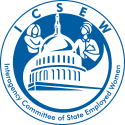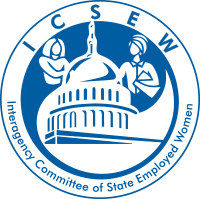Meeting Recap: GROW, Census Topics at September 2019 Meeting
Story and Photos by Rachel Friederich, ICSEW Commununications Chair
TUMWATER—Representatives from Thrive at Work, LLC taught attendees at the ICSEW’s Sept. 17 meeting some tips on how to realize their goals and offered some insightful tips on how to overcome barriers those goals using the GROW process.

GROW is an acronym that describes four stages of the goal setting process.
- Goal: Figure out what you want to accomplish
- Reality check: Look at you goal and think about its real impacts on your life. What are the existing pros and cons to reaching your goal?
- Options: What are potential ways to move forward (this is where you list as many possible action steps you could take to move towards the goal)
- Way forward. Pick an option and commit to action
John Utter and Damon Drown, also gave participants a set of tips and questions to ask themselves at each stage of the GROW process.
For example, during the Goal stage, make sure it’s SMART. (Simple, Measurable, Actionable, Relevant and Time-Bound) Is your goal too complex? How will you know when you’ve reached your goal?
During the Reality check stage, ask things like: What resources do you have to reach your goal? What are some of the barriers keeping you from reaching your goal?
Options stage: What ways has your situation been handled successfully/unsuccessfully before? Who might be an ally to help you reach your goal?
Way forward stage: What actions can you commit to? When are you going to take these steps?
Click here for the complete set of GROW questions.
Census 2020

Lisa McLean, a coordinator for the Complete Count Committee gave an overview of the 2020 census.
The Federal government does a census every ten years. It’s meant to give government a “point-in-time” look at the demographics that make up America. The data collected can be used to distribute political power by redrawing electoral boundaries; distribute federal and state funds for things like health care, education, highway and rural programs assistance; infrastructure planning and to inform decision-making of businesses, non-profits and philanthropic organizations.
McLean also talked about when the census would be mailed out and the overall questionnaire structure. McLean also talked about what the US Census Bureau does to reach people who can’t be reached via mail to a physical home address. For example, homeless populations, and people with PO Boxes and people who do not respond to the census. The Census Bureau has workers who go door-to-door to help these populations complete the census.
The Office of Financial Management has also compiled a list of links about the 2020 Census:
- What’s At Stake
- What You Need to Know
- The 2020 Census and Confidentiality
- Spotting a Census Scam
- Washington’s revenue from 55 federal spending programs in 2016
- Language Assistance in the 2020 Census
The PowerPoint presentation and handouts from the GROW process training will be posted with the meeting minutes.

